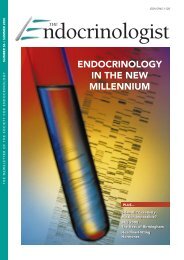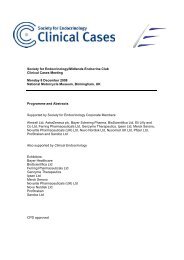Standards for undergraduate medical education - Society for ...
Standards for undergraduate medical education - Society for ...
Standards for undergraduate medical education - Society for ...
You also want an ePaper? Increase the reach of your titles
YUMPU automatically turns print PDFs into web optimized ePapers that Google loves.
Coding Cat Diagnosis HRG Fee (approx)<br />
No coding – – £0<br />
Outpatient attendance – – £75-£150<br />
Daycase admission<br />
Some, but not all, HRGs recognise whether the patient has<br />
additional conditions that can complicate the primary<br />
diagnosis, and allocate a higher tariff. These will vary<br />
depending on the HRG generated. Un<strong>for</strong>tunately it isn’t<br />
always clear which one(s) will trigger the higher tariff. A<br />
patient may have a handful of co-morbidities, but it may<br />
only be one that attracts the higher level.<br />
To facilitate the above process you may find it helpful to<br />
use a coding summary sheet. This can convey the clinical<br />
in<strong>for</strong>mation, without missing important details such as the<br />
presence of a tumour. Basic knowledge of how endocrine<br />
tests are coded can help your department avoid missing<br />
out on income to which it is entitled.<br />
BEN WHITELAW, SIMON AYLWIN<br />
With thanks to Claire Yates, Senior Clinical Coder at<br />
King’s College Hospital, <strong>for</strong> her advice.<br />
Cushing’s disease Anterior pituitary disorder (KA05B) £600<br />
Pituitary tumour Brain tumour (AA24Z) £700<br />
In summary:<br />
Find out how your hospital is funded <strong>for</strong> dynamic<br />
endocrine tests. If they are coded as outpatient<br />
attendances you may be receiving only 25% of the<br />
potential day case fee.<br />
If your patient has a tumour diagnosis, ensure that<br />
this in<strong>for</strong>mation is available to the clinical coding<br />
department, so that your trust does not miss out on<br />
about 15% of the revenue available <strong>for</strong> the visit.<br />
Succinct in<strong>for</strong>mation on co-morbidities is useful <strong>for</strong><br />
coding and may help your trust avoid missing other<br />
income. There is a list of mandatory co-morbidities<br />
available that coders are required to capture.<br />
Structuring in<strong>for</strong>mation <strong>for</strong> the coding department,<br />
<strong>for</strong> instance using a coding summary sheet, may<br />
ensure that they are fully in<strong>for</strong>med.<br />
FEATURES<br />
‘Pituitary PROMS’: how and why should<br />
we assess pituitary patient satisfaction<br />
Why assess patient satisfaction<br />
When we audit patient outcomes in pituitary clinics, we<br />
tend to think in terms of surgical complications, residual<br />
tumour volumes, improvements in visual fields, pituitary<br />
function and biochemical control rates. We assume that if<br />
these outcomes are good, our patients will be satisfied.<br />
However, many external drivers now encourage us to<br />
assess ‘patient-reported outcome measures’ (PROMS) and<br />
seek regular ‘service user feedback’. These include the<br />
NICE Improving Outcomes Guidance (IOG) <strong>for</strong> CNS<br />
tumours, and individual/team revalidation.<br />
Most endocrinologists share an interest in the quality of<br />
life of their patients and in trying to identify and address<br />
unmet needs. We would like to embrace these drivers,<br />
rather than viewing them as ‘tick box exercises’, but how<br />
do we do this, within the constraints of current resources,<br />
and can we apply the same methodological standards that<br />
we use in our research to service improvement<br />
Our approach<br />
In Brighton, we worked with Dr Sue Jackson using<br />
questionnaires that she had used previously <strong>for</strong><br />
nationwide surveys on behalf of The Pituitary Foundation<br />
in 2005 and 2008. We focused a 4th year <strong>medical</strong> student<br />
project around conducting a needs analysis and patient<br />
satisfaction survey.<br />
What we learnt<br />
Neither we (as a team) nor our patients are doing as well<br />
as we thought! We found out about the lengthy diagnostic<br />
process many patients go through, with only a third of<br />
patients diagnosed in fewer than seven visits to their GP.<br />
We discovered a thirst <strong>for</strong> more written in<strong>for</strong>mation across<br />
a breadth of topics, including diet and nutrition,<br />
professional support services and complementary services<br />
(this may be a ‘Brighton’ phenomenon!). A significant<br />
minority were dissatisfied with their treatment regimen.<br />
The impact on patients’ lives went beyond that<br />
appreciated during regular consultations, with a quarter<br />
having either given up work or accepted lower career<br />
prospects and a third dissatisfied with sex, although threequarters<br />
were satisfied with their relationships. Although<br />
psychological morbidity was mostly mild to moderate, a<br />
third of patients had clinical levels of anxiety, a fifth had<br />
clinical levels of depression, and two-thirds had reduced<br />
quality of life in at least one of the domains assessed.<br />
What next<br />
Results like these can be used to develop local action plans<br />
and support business cases <strong>for</strong> service development. There<br />
is also a need to develop simpler but properly validated<br />
tools to assess patient satisfaction and identify unmet<br />
continued on page 20<br />
T H E E N D O C R I N O L O G I S T • I S S U E 1 0 3 • S P R I N G 2 0 1 2<br />
19



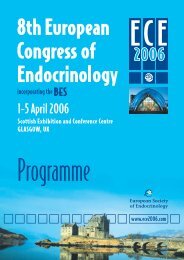
![The Endocrinologist | Issue 99 [PDF] - Society for Endocrinology](https://img.yumpu.com/48213777/1/184x260/the-endocrinologist-issue-99-pdf-society-for-endocrinology.jpg?quality=85)

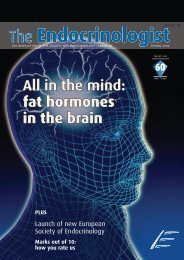
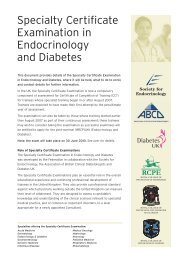
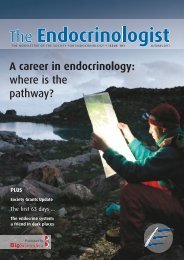
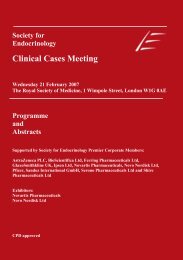

![The Endocrinologist | Issue 97 [PDF] - Society for Endocrinology](https://img.yumpu.com/40840065/1/184x260/the-endocrinologist-issue-97-pdf-society-for-endocrinology.jpg?quality=85)

